
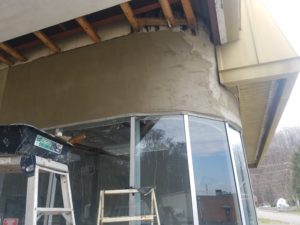
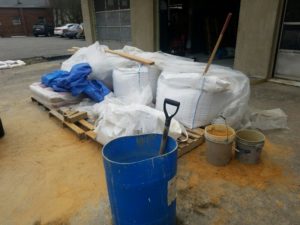
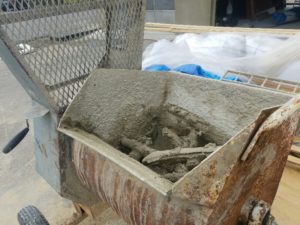
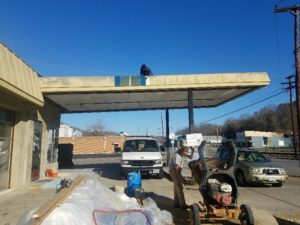
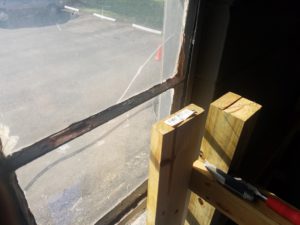 Work space, trying to remove windows with a chisel and hammer without breaking the good windows
Work space, trying to remove windows with a chisel and hammer without breaking the good windows
Our work with the service station in Bassett is coming to a close. We are hard at work applying mud to the outside of the building, creating an even surface on which we may apply stucco. The “mud” that we are smoothing onto the walls is a mixture of mortar, sand and water. I was surprised that it was not more complicated than that, which lead to an interesting conversation on the history of masonry with James, our lead brick mason. These building techniques have changed little since they were first developed in ancient Rome based on Greek, Egyptian and north African Phoenician building techniques. It is very satisfying for myself that I can work in a trade that has such a vast history and heritage. It really feels like I am taking part in an eons-old trade.
As we are finishing up the roughing-in of the finished masonry, we just have to finish the stucco well enough for the painters to be able to get to work. The finished building is going to be finished white with green trim and a green roof, according to the last conversation the client had with my boss. This is the first in a long list of potential sites in Bassett that can be worked on. The grant money that is coming in from the state applies to the entire main street, which includes at least another dozen buildings including an old train station. One local was especially enthusiastic about the renovations coming to the downtown area. An older gentleman and presumably his grandson, pulled up to our job site the other day in a red pick up. I talked with him for a while about what we were doing, and he told me about the memories that he had of the service shop going back to his childhood sixty years earlier. He expressed his excitement for the restoration that we were doing, especially because we are restoring it to the original appearance that the station had in its height, some sixty years earlier.
A few lessons that I have learned working with Southwest Restoration beyond how to lay mortar or tap masonry nails or set up scaffolding have been helpful and in retrospect, common sense. First, anticipate, anticipate, anticipate. If there is a guy fifteen feet above you that is laying mortar on brick as fast as possible, stand by with towels, more mortar and a bucket of water. If those things are needed, they are needed right then. If you are walking around with scaffolding bucks and braces, watch where you are going and carry it from place to place in order. There is nothing more aggravating than having the wrong pieces of scaffolding in odd places around the job site. The second lesson is, if you work slower, you go faster. This seems counter-intuitive but when it came to spreading mortar on the inside of a garage door fifteen feet above the ground on a ladder, this was unbearably true. You will spend more time fixing mistakes you make from rushing than you will ever save by working quickly. If its done right the first time, you can get done before 3:30 and maybe leave early. Lastly, clean up as you go. There is nothing worse than having piles of refuse and construction scraps laying around the job site at the end of the day when you may have a cut on your thumb, a pulled back muscle and maybe a little sore from hauling mortar. These lessons were integral to making peace with the more difficult aspects of my internship, and fortunately they were fairly easy and straight-forward lessons to grasp.